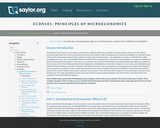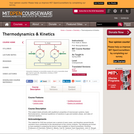
- Subject:
- Economics
- Social Science
- Material Type:
- Unit of Study
- Provider:
- Rice University
- Provider Set:
- OpenStax College


By the end of this section, you will be able to:
Explain protectionism and its three main forms
Analyze protectionism through concepts of demand and supply, noting its effects on equilibrium
Calculate the effects of trade barriers


By the end of this section, you will be able to:
Predict shifts in the demand and supply curves of the labor market
Explain the impact of new technology on the demand and supply curves of the labor market
Explain price floors in the labor market such as minimum wage or a living wage

14.01 Principles of Microeconomics is an introductory undergraduate course that teaches the fundamentals of microeconomics. This course introduces microeconomic concepts and analysis, supply and demand analysis, theories of the firm and individual behavior, competition and monopoly, and welfare economics. Students will also be introduced to the use of microeconomic applications to address problems in current economic policy throughout the semester.
This course is a core subject in MIT's undergraduate Energy Studies Minor. This Institute-wide program complements the deep expertise obtained in any major with a broad understanding of the interlinked realms of science, technology, and social sciences as they relate to energy and associated environmental challenges.
Course Format
This course has been designed for independent study. It includes all of the materials you will need to understand the concepts covered in this subject. The materials in this course include:
A complete set of Lecture Videos by Prof. Jon Gruber.
Reading Assignments in your choice of two textbooks – one of which is a free online edition - as preparation for the lectures.
Multiple-choice Quizzes to assess your understanding of the key concepts in each session.
Problem Sets with solution keys to test your ability to apply to concepts covered in lecture, and Problem Solving Videos to provide step-by-step instruction through several problem set solutions.
A collection of links For Further Study to provide supplemental online content.
A full set of Exams, including review material and practice exams to help you prepare.

The purpose of this course is to provide the student with a basic understanding of the principles of microeconomics. At its core, the study of economics deals with the choices and decisions that have to be made in order to manage scarce resources available to us. Microeconomics is the branch of economics that pertains to decisions made at the individual level, i.e. by individual consumers or individual firms, after evaluating resources, costs, and tradeoffs. "The economy" refers to the marketplace or system in which these choices interact with one another. In this course, the student will learn how and why these decisions are made and how they affect one another in the economy. Upon successful completion of this course, students will be able to: Think intuitively about economic problems; Identify how individual economic agents make rational choices given scarce resources and will know how to optimize the use of resources at hand; Understand some simplistic economic models related to Production, Trade, and the Circular Flow of Resources; Analyze and apply the mechanics of Demand and Supply for Individuals, Firms, and the Market; Apply the concept of Marginal Analysis in order to make optimal choices and identify whether the choices are 'efficient' or 'equitable'; Apply the concept of Elasticity as a measure of responsiveness to various variables; Identify the characteristic differences amongst various market structures, namely, Perfectly Competitive Markets, Non-Competitive Markets, and Imperfectly Competitive Markets and understand the differences in their operation; Analyze how the Demand and Supply technique works for the Resource Markets. (Economics 101; See also: Business Administration 200)

Explore what makes a reaction happen by colliding atoms and molecules. Design experiments with different reactions, concentrations, and temperatures. When are reactions reversible? What affects the rate of a reaction?

Explore what makes a reaction happen by colliding atoms and molecules. Design experiments with different reactions, concentrations, and temperatures. When are reactions reversible? What affects the rate of a reaction?

Oxidation and reduction reactions power your phone and make it possible for your body to use the oxygen you inhale. We will learn about oxidation states (numbers), oxidation-reduction (redox) reactions, galvanic/voltaic cells, electrolytic cells, cell potentials, and how electrochemistry is related to thermodynamics and equilibrium.

The concepts of stability and equilibrium are introduced while students learn how these ideas are related to the concept of center of mass. They gain further understanding when they see, first-hand, how equilibrium is closely related to an object's center of mass. In an associated literacy activity, students learn about motion capture technology, the importance of center of gravity in animation and how use the concept of center of gravity in writing an action scene.

Students learn that engineers develop different polymers to serve various functions and are introduced to selectively permeable membranes. In a warm-up activity, they construct models of selectively permeable membranes using common household materials, and are reminded about simple diffusion and passive transport. In the main activity, student pairs test and compare the selective permeability of everyday polymer materials engineered for food storage (including plastic grocery bags, zipper sandwich bags, and plastic wrap) with various in-solution molecules (iodine, corn starch, food coloring, marker dye), assess how the polymer’s permeability relates to its function/purpose, and compare that to the permeability of dialysis tubing (which simulates a cell membrane).

This course covers the general principles of separation by equilibrium and rate processes. Topics include staged cascades and applications to distillation, absorption, adsorption, and membrane processes. Phase equilibria and the role of diffusion are also covered.

Statica is de leer van mechanisch evenwicht.
Een lichaam beweegt niet (of is in een éénparige rechtlijnige beweging) als de som van de krachten die op dat lichaam werken nul is. Als ook de som van de momenten die op dat lichaam werken nul is, dan roteert het lichaam ook niet.
De consequentie van deze twee evenwichtsvoorwaarden (som van krachten =0 en som van momenten =0), is dat voor een lichaam waarop een aantal bekende krachten werken de (onbekende) reactiekrachten bepaald kunnen worden .
Dit is van groot belang omdat de grootte van de reactiekrachten de dimensionering en materiaalkeuze van toe te passen componenten bepalen.
Binnen het vak “Statica” wordt in detail ingegaan op de verschillende mechanische belastingen, vaak voorkomende constructies en hoe te rekenen met de diverse belastingen.

Statics deals with the principles of equilibrium. In this course the principles of forces and moments will be explained as well as principle of equilibrium of forces and moments. This also includes the equilibrium of 2D and 3D structures and trusses. Furthermore the principle of internal forces and moments is addressed as well as the use of the principle of virtual work to calculate both external and internal loads. Finally, the concepts of centre of gravity, centroids and moments of inertia are discussed

Students are introduced to static equilibrium by learning how forces and torques are balanced in a well-designed engineering structure. A tower crane is presented as a simplified two-dimensional case. Using Popsicle sticks and hot glue, student teams design, build and test a simple tower crane model according to these principles, ending with a team competition.

This subject deals primarily with equilibrium properties of macroscopic systems, basic thermodynamics, chemical equilibrium of reactions in gas and solution phase, and rates of chemical reactions.

This subject deals primarily with equilibrium properties of macroscopic systems, basic thermodynamics, chemical equilibrium of reactions in gas and solution phase, and rates of chemical reactions.
Acknowledgements
The material for 5.60 has evolved over a period of many years, and therefore several faculty members have contributed to the development of the course contents. The following are known to have assisted in preparing the lecture notes available on OpenCourseWare: Emeritus Professors of Chemistry: Robert A. Alberty, Carl W. Garland, Irwin Oppenheim, John S. Waugh. Professors of Chemistry: Moungi Bawendi, John M. Deutch, Robert W. Field, Robert G. Griffin, Keith A. Nelson, Robert J. Silbey, Jeffrey I. Steinfeld. Professor of Bioengineering and Computer Science: Bruce Tidor. Professor of Chemistry, Rice University: James L. Kinsey. Professor of Physics, University of Illinois: Philip W. Phillips.

To learn about the concept of center of mass, students examine how objects balance. They make symmetrical cut-outs of different "creatures" and experiment with how they balance on a tightrope of string. Students see the concept of center of mass at work as the creatures balance.

What is economics and why should you spend your time learning it? After all, there are other disciplines you could be studying, and other ways you could be spending your time. As the Bring it Home feature just mentioned, making choices is at the heart of what economists study, and your decision to take this course is as much an economic decision as anything else.
Economics is probably not what you think it is. It is not primarily about money or finance. It is not primarily about business. It is not mathematics. What is it then? It is both a subject area and a way of viewing the world.